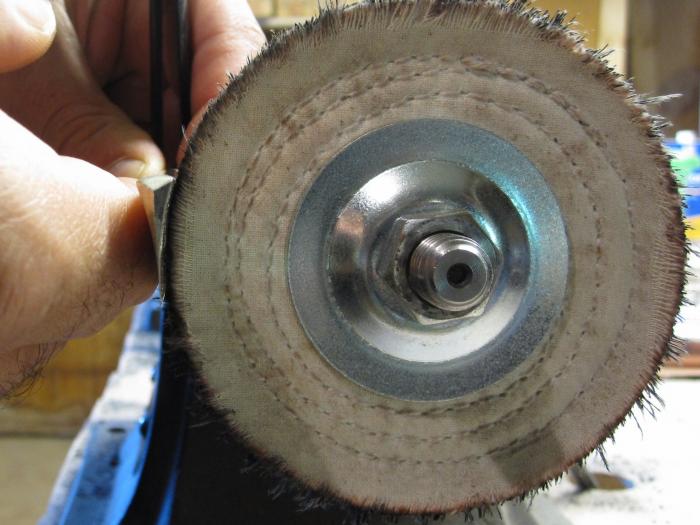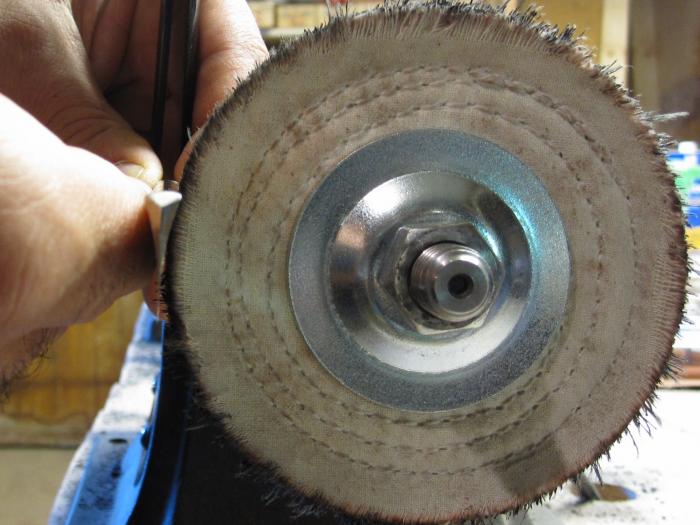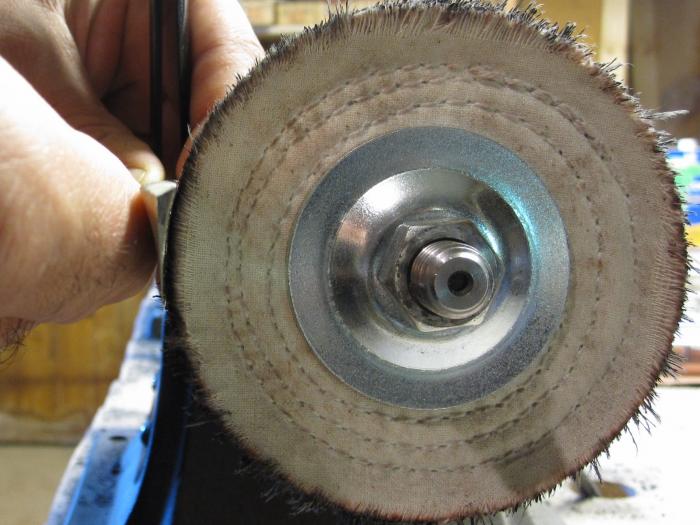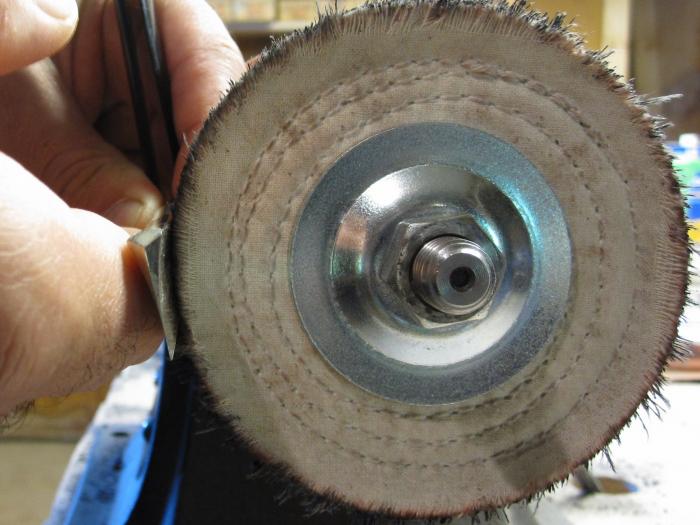Results 11 to 20 of 24
-
07-10-2010, 08:18 AM #11

Thanks for helping out with this, Glen.
You're definitely right that the explanation is difficult. I'm having trouble getting a few of the terms you're using.
What do you mean when you talk about moving the blade "back" or "straight down"? I think you wrote that rocking the razor back is what messes up the edge, but I don't quite get what that means.
Also, what did you mean by "following the wheel"? Is the alternative to add pressure to make the wheel deform around the razor? I didn't quite get that idea either.
Now to go figure out how you're holding that razor so that your index finger is on the back. I'll play with that a little before I go to sleep tonight
-
07-10-2010, 04:05 PM #12


- Join Date
- May 2005
- Location
- St. Louis, Missouri, United States
- Posts
- 8,454
- Blog Entries
- 2
Thanked: 4942
There is a built in dilemma when using the greaseless compounds and a horizontal approach to the wheels. The problem is that usually, any pressure on the spine of the razor will cause the razor to shoot down or out of your hands if you are not careful. Same thing can happen on the regular compounds too. If you lead into the wheel with the edge, you will always get the kind of damage you are describing. This can also happen with fast cutting bars like the grey and emory (black) and depending on your speed, can cause all sorts of fun. You have to be very careful as Glen describes and got direct into the wheel lightly on the areas you want to hit.
I find that when I start, I like to go with the emory at first or even 600 grit on the greaseless just to see what I'm up against and then determine if I need to go with a courser grit.
Be careful with any greaseless as well as high speed about the blade getting warm. It is very easy to alter the temper if you are not careful. Keep water close.........
I tend to buff lengthwise a lot more than horizontal, but this is just my preference and practice along with your results will determine what works best for you.
Have fun,
Lynn
-
07-10-2010, 04:54 PM #13At this point in time...




- Join Date
- Jun 2007
- Location
- North Idaho Redoubt
- Posts
- 27,037
- Blog Entries
- 1
Thanked: 13249
I bet pics will help
I'll get out to the shop and try and take some tonight...
As soon as you see what I mean yer gonna go "God that is easy" but it makes a huge difference...
+1 with Lynn too, I usually buzz a blade with 600 first to see what is what before, I start burning off metal..
-
07-11-2010, 04:41 PM #14At this point in time...




- Join Date
- Jun 2007
- Location
- North Idaho Redoubt
- Posts
- 27,037
- Blog Entries
- 1
Thanked: 13249
OK my picture taking abilities are much to be desired, I even tried having the wife help, so after two cameras and about 30 pics these are the best I could get....
These first 3 are what I consider to be the correct way to buff the blade, I have really good control with my finger against the back of the blade, and I can feel heat build up in an instant, lastly and most importantly, if the spine catches my fingers are nowhere near the edge...



The last pic here is what the whole thread started over... If you look in all the pics above, the edge is pointing straight down... Here the edge is tilted back toward the wheel which causes the wheel to burn through the edge, which results in a frown being cut very quickly in the razor.... Keep the edge pointing straight down that is what I was trying to explain...

See I told you it was much harder to explain, and very easy to understand
-
The Following 12 Users Say Thank You to gssixgun For This Useful Post:
-
07-11-2010, 06:55 PM #15

The pictures definitely made your explanation clear. Especially with the last one for comparison.
I see what you mean about placing your finger along the spine, too. I have been placing my as your pictures show, as well as using my thumb in the same way.
The biggest thing appears to be the angle of the blade in combination with where the point of the blade initially contacts the wheel.
Once again, thanks so much for the advice! I just got in a rather rusty M. Boker & Co. with a worked back and a barber's notch, and I didn't want to go any where near it before (quite a bit more practice and) understanding what I needed to be doing to avoid a shiny, but frowning, blade.
I just got in a rather rusty M. Boker & Co. with a worked back and a barber's notch, and I didn't want to go any where near it before (quite a bit more practice and) understanding what I needed to be doing to avoid a shiny, but frowning, blade.
-
07-12-2010, 05:17 AM #16

Glen, that was all very very helpful. Thank you for the pics! It really was as easy to understand as you said it would be, lol
-
07-12-2010, 07:21 PM #17illegitimum non carborundum



- Join Date
- Jan 2008
- Location
- Rochester, MN
- Posts
- 11,552
- Blog Entries
- 1
Thanked: 3795
The index finger issue had me confused too! I thought the hand holding the razor was the hand with the index finger behind the blade and I could not figure out how the heck that was accomplished. The photo definitely helped. It turns out I do the same thing. I just didn't give it a thought.
-
07-13-2010, 01:03 AM #18Senior Member

- Join Date
- Jul 2006
- Location
- Albuquerque
- Posts
- 133
Thanked: 16
This thread was a good learning experience for me. I've been using my dremel to clean up eBay razors for a good number of years and have started reading the buffing machine threads and watching the related videos as I'm considering the next step. On the other hand, I already have enough razors for many many lifetimes.
-
07-13-2010, 01:26 AM #19

I find that using any sort of pressure is bad. It generates a lot of heat, becomes quickly unsafe, etc...
When I am using low grit greaseless, I am using very little pressure in my videos...letting the compound do the work... the more you press into the compound, the more likely it is to detach/come off the wheel..causing you to have to constantly reload..thereby making any time you saved through faster metal removal negated due to the fact you have to reload the wheel...
I also spend minimal amount of time buffing near the edge / applying pressure @ the cutting edge. I typically hold most of the pressure near the spine, I guess I'd say. If you ever see pitting on my razors after I've run them through the progression, its usually near the edge / on the lower half of my blades, because I actually get nervous down there...heat can build up quickly on thin metal and there is just no reason to ruin a blade....no pit removal is worth ruining sometthing IMO.
I guess my advice will be, glens recommendations + some careful guidance of the blade to ensure you're not spending too much time right on the edge...and then a LOT of practice. hehe.
-
07-13-2010, 01:38 AM #20

I haven't been able to buff edge down without creating a frown in a razor; after consulting with my go to mentors, Lynn and JoeD, I've started buffing with the blade lengthwise. I also use only about half the width of my wheel at a time to ensure that I'm not working the edge.
Here are two photos I have (not as good as Glen's) to show what I mean. Note in each, the edge is off the wheel. Depending on how hollow the razor is, I walk the blade left to right to get into the hollow, but always keep the edge off the wheel.Last edited by holli4pirating; 07-13-2010 at 01:40 AM.
-


 13Likes
13Likes LinkBack URL
LinkBack URL About LinkBacks
About LinkBacks







 Reply With Quote
Reply With Quote
